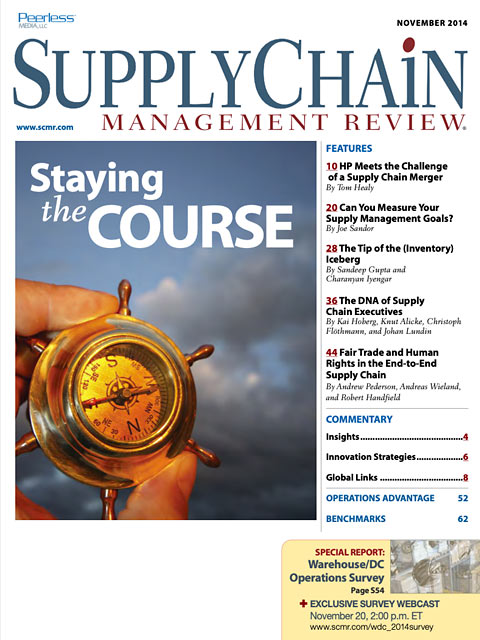Sorry, but your login has failed. Please recheck your login information and resubmit. If your subscription has expired, renew here.
November 2014
Supply chain managers are on the lookout for metrics that will allow them to put a number to their progress - or lack thereof. Welcome to KPI's that allow them to demonstrate the quantifiable value that they deliver. At the same time, Murphy's Law may intervene or they may be called upon to put out fires or come to the rescue and make good on the promises sales and marketing have made to customers - regardless of the cost. So, how do you measure success? I hope this month's issue and online bonus feature help you consider how you measure your progress. Browse this issue archive.Need Help? Contact customer service 847-559-7581 More options
U.S. companies made only marginal improvements in their ability to collect from customers and pay suppliers in 2013, while showing no improvement in how well they managed inventory, according to the 16th Annual Working Capital Survey from REL, a division of the Hackett Group, Inc.
“For inventory, the global marketplace has made issues like demand planning more important than ever before,” says Analisa DeHaro, Associate Principal for REL. “Companies need to factor in lead times that may not have been an issue when manufacturing was done closer to home. The best companies are becoming more savvy about this, and are more effectively balancing the various elements of inventory
management.”
The amount tied up in excess working capital at nearly 1000 of the largest public companies in the U.S. is over a trillion dollars, according to the REL research.
 |
This complete article is available to subscribers
only. Click on Log In Now at the top of this article for full access. Or, Start your PLUS+ subscription for instant access. |
SC
MR
Sorry, but your login has failed. Please recheck your login information and resubmit. If your subscription has expired, renew here.
November 2014
Supply chain managers are on the lookout for metrics that will allow them to put a number to their progress - or lack thereof. Welcome to KPI's that allow them to demonstrate the quantifiable value that they… Browse this issue archive. Access your online digital edition. Download a PDF file of the November 2014 issue. |
Download Article PDF |
U.S. companies made only marginal improvements in their ability to collect from customers and pay suppliers in 2013, while showing no improvement in how well they managed inventory, according to the 16th Annual Working Capital Survey from REL, a division of the Hackett Group, Inc.
“For inventory, the global marketplace has made issues like demand planning more important than ever before,” says Analisa DeHaro, Associate Principal for REL. “Companies need to factor in lead times that may not have been an issue when manufacturing was done closer to home. The best companies are becoming more savvy about this, and are more effectively balancing the various elements of inventory management.”
The amount tied up in excess working capital at nearly 1000 of the largest public companies in the U.S. is over a trillion dollars, according to the REL research.
 |
SUBSCRIBERS: Click here to download PDF of the full article. |
SC
MR

Latest Supply Chain News
- Survey reveals strategies for addressing supply chain, logistics labor shortages
- Israel, Ukraine aid package to increase pressure on aerospace and defense supply chains
- How CPG brands can deliver on supplier diversity promises
- How S&OP provides the answer to in-demand products
- AI, virtual reality is bringing experiential learning into the modern age
- More News
Latest Podcast

 Explore
Explore
Topics
Latest Supply Chain News
- Survey reveals strategies for addressing supply chain, logistics labor shortages
- Israel, Ukraine aid package to increase pressure on aerospace and defense supply chains
- How CPG brands can deliver on supplier diversity promises
- How S&OP provides the answer to in-demand products
- AI, virtual reality is bringing experiential learning into the modern age
- Humanoid robots’ place in an intralogistics smart robot strategy
- More latest news
Latest Resources

Subscribe

Supply Chain Management Review delivers the best industry content.

Editors’ Picks





